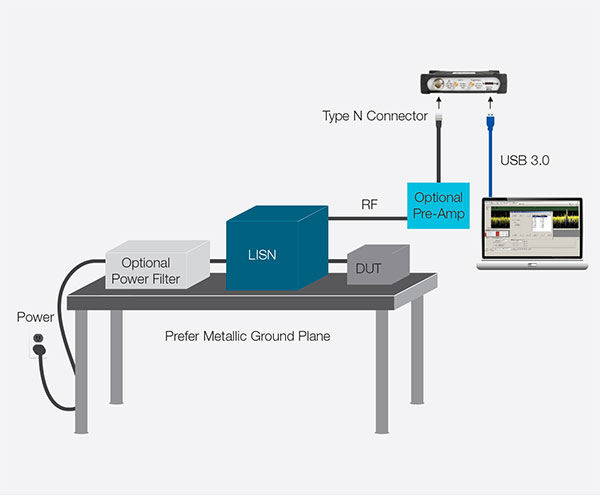お問い合わせ
ダウンロード
マニュアル、データシート、ソフトウェアなどのダウンロード:
フィードバック
伝導、放射エミッションの測定
50%のプロジェクトでは、初回のEMI/EMCテストが不合格になるという事実をご存じでしょうか。 Intertek Testing Servicesの報告によると、製品のおよそ半分が最初のEMCテストに失敗しています。その原因として、EMC原則適用の失敗、EMC/EMIに関する知識の欠如、EMC規制の誤った適用、回路エレメント間の予期しない相互作用、または非準拠モジュールまたはサブアセンブリが最終製品に組み込まれることが挙げられています。
EMI/EMCプリコンプライアンス・テストを実行することにより、EMIコンプライアンス・テストに1回で合格できる可能性が高くなり、時間や数十万円の費用を節約することができます。 医療、自動車、防衛、さらにはマルチメディア・アプリケーション用の製品を設計している企業は、プリコンプライアンス・テスト・セットアップに投資することで利益を得ることができます。 このページでは、プリコンプライアンス・テストを製品開発プロセスに追加することで、製品開発を加速し、プロジェクト・コストを削減する方法について説明します。EMC/EMIテストの基礎について詳しく学ぶ。
EMI/EMCプリコンプライアンス・テスト・ソリューション
テクトロニクスは、お求めやすい価格のソフトウェア、スペクトラム・アナライザ、アクセサリ、プローブなどのEMI/EMCプリコンプライアンス・テスト・ソリューションを提供しています。
ソフトウェア
SignalVu-PCとEMCVuソフトウェアがあれば、テクトロニクスのEMI/EMCプリコンプライアンス・ソリューションをすぐにご利用いただけます。 SignalVu-PCのプラグインとして、EMCVuはすべてのプリコンプライアンスのニーズに対応するシングル・ユーザ・インタフェースを提供します。
スペクトラム・アナライザ
テクトロニクスは、高速かつ正確な測定を提供してEMI/EMCの問題を迅速に検出する、お求めやすい価格の幅広いリアルタイム・スペクトラム・アナライザのラインアップを提供しています。リアルタイム・スペクトラム・アナライザは、まれに発生するEMIバーストを取込むという、従来の掃引タイプに比べて大きな利点があります。
EMI/EMC測定に関する製品
操作性に優れたプリコンプライアンス・ソフトウェア
SignalVu-PCとEMCVu
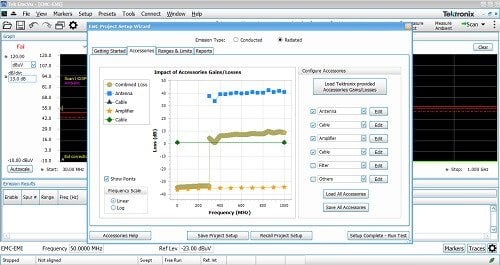
SignalVu-PCとEMCVuソフトウェアがあれば、テクトロニクスのEMI/EMCプリコンプライアンス・ソリューションをすぐにご利用いただけます。 EMCVuはすべてのプリコンプライアンスのニーズに対応するシングル・ユーザ・インタフェースを提供します。 EMCVuソフトウェアのライセンスをご購入いただくだけで、SignalVu-PCに内蔵されたEMCVuの機能のロックが解除されます。
低コストのプリコンプライアンス
リアルタイム・スペクトラム・アナライザ

テクトロニクスは、手頃な価格のRSA306B型から高性能のRSA5000シリーズまで、リアルタイム・スペクトラム・アナライザのフル・ラインアップを取り揃えています。すべてのテクトロニクス・スペクトラム・アナライザには、スペクトラム解析用のSignalVuソフトウェアが含まれています。
ミックスド・ドメイン解析機能を高度に統合したオシロスコープ
4/5/6シリーズMSOオシロスコープ
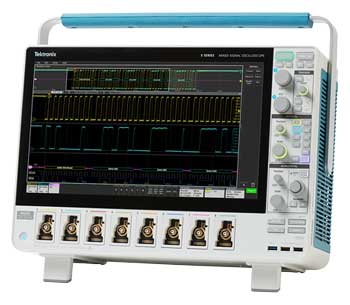
これらのオシロスコープは、スペクトラム表示によって任意のアナログ・チャンネルの時間領域の波形、スペクトラム、またはその両方を表示できるなど、優れた汎用性を備えています。時間および周波数のプロットが同期されるため、ビクティム/アグレッサの信号を効果的に識別できます。
時間と周波数の同期解析
MDO4000シリーズ

EMI信号や、アナログ、デジタル、RFの相関的な異常を的確に特定できる強力なトリガ/サーチ/解析ツールをご利用ください。 MDO4000シリーズはロジック・アナライザ、スペクトラム・アナライザ、プロトコル・アナライザを内蔵しており、それぞれが同期しているため、統合された観測が行えます。
EMI/EMCプリコンプライアンス・テストの利点
製品開発に携わっている場合、製品を市場に出すためにコスト、時間、時には感情的な情熱という投資が必要になります。コンプライアンス・テストの不合格はぜひとも避けたいものです。プリコンプライアンス・ソリューションを作業プロセスに組み込むことには、以下のような数多くの利点があります。
- 製品化までの時間の遅延や開発コストの増加の原因となるEMI/EMCの潜在的な問題を早期に特定できる
- EMI/EMC関連のコストを削減できる
- 認証ラボに持ち込む前に製品の信頼性を向上させる
- 設計変更の影響に関するフィードバックを即時に行う
- スケジュールに合わせて柔軟にテストを行うことが可能

設計の初期段階で導入した場合、優れたEMC設計手法の実装はそれほど難しくありません。 EMC要件を満たすために設計の後半で変更を加える必要がある場合は、非常に難しくなります。
EMI/EMCプリコンプライアンス・テストのセットアップ

テクトロニクスのRSA500シリーズUSBスペクトラム・アナライザを使用した、代表的な放射テストのセットアップ
EMI/EMCプリコンプライアンス・テストは簡単で、時間もかかりません。顧客からのフィードバックに基づいて、テクトロニクスは、使いやすさと機能性を念頭に置いた、放射、伝導のプリコンプライアンス・テストが行える次世代ソフトウェアを開発しました。
EMI/EMCプリコンプライアンス・テストのセットアップは、SignalVu-PCから始まります。EMCVuと呼ばれる追加オプションを使用することで、この最新版のSignalVu-PCをご利用いただけるようになります。EMCVuには、使いやすい設定ウィザード、内蔵された規格、押しボタンによる選択機能を備えたアクセサリ設定機能が備わっています。オープンエア・テスト・サイト(OATS)をセットアップする場合でも、研究室でテストしている場合でも、EMCVuは周囲の雑音を取込んで除去するため、無響室を使用せずにプリコンプライアンス・テストの精度を高めます。
EMCVuとスペクトラム・アナライザおよびアクセサリを使用して、放射、伝導エミッションのプリコンプライアンス・テストを実行する方法の詳細については、このアプリケーション・ノートをダウンロードしてください。
30日間の無償試用版でEMCVuをお試しになりたい方は、以下のボタンをクリックしてください。
テクトロニクスEMI/EMCのプリコンプライアンス・ソリューションでサポートされる規格
テクトロニクスのEMCVuプリコンプライアンス・ソフトウェアは、CISPR、FCC、MIL-STDなど、多くのEMC規格をサポートしています。テストを自動化するために、EMCVuには内蔵の規格が備わっているので、製品とその販売地域に適した規格を選択することができます。EMCVuでは、周波数範囲の設定やライン・テーブルの制限など、含まれていない機能を持つ規格を設定することもできます。
サポートされる規格の簡単な要約を以下に示します。
| マーケット・セグメント | 機器の種類 | 規格 | ||||
|---|---|---|---|---|---|---|
| IEC/CISPR | CENELEC/EN | FCC | MIL-STD | DEF-STAN | ||
| ISM医療 | 産業、科学、医療機器 | CISPR 11 | EN 55011 | CFR Title 47 Part 18 | ||
| 医療用の電気機器 | EN 60601-1-2 | |||||
| 自動車 | 自動車、船舶、内燃エンジン | CISPR 12 | EN 55012 | CFR Title 47 Part 15(*) | ||
| 搭乗車両のコンポーネントおよびモジュール | CISPR 25 | EN 55025 | ||||
| マルチメディア | サウンドおよびTV放送レシーバ | CISPR 13 | EN 55013 | CFR Title 47 Part 15 | ||
| 情報技術と通信機器(ITE) | CISPR 22 (EN55032に置き換え) | EN 55022 (EN55032に置き換え) | ||||
| プロ・オーディオ/ビデオ/マルチメディア機器 | CISPR 32 (CISPR 13および22に置き換え) | EN 55032 | ||||
| 電化製品 | 電気デバイス、家庭用電化製品およびツール | CISPR 14-1 | EN 55014-1 | CFR Title 47 Part 15 | ||
| 照明 | 蛍光灯および照明 | CISPR 15 | EN 55015 | CFR Title 47 Part 15 | ||
| 防衛 | 防衛機器とシステム | MIL-STD-461G | DEF-STAN 59-411 | |||
デバッグ作業を高速化するためのトラブルシューティングのヒント
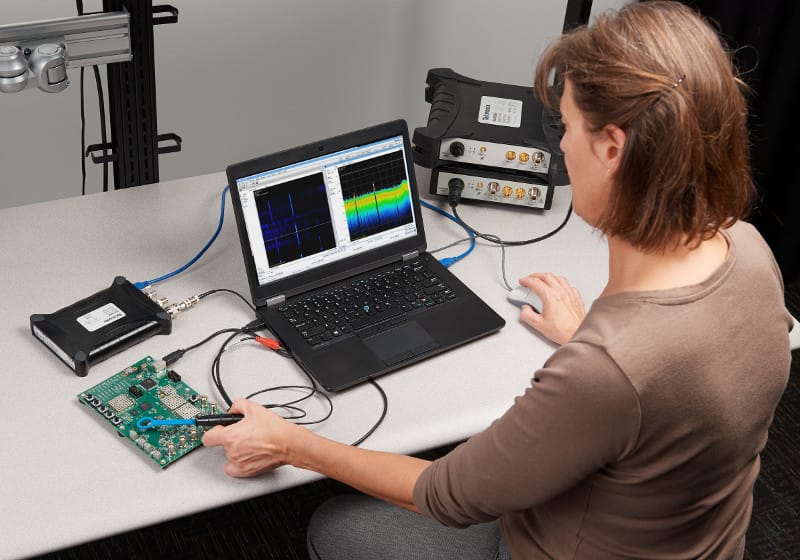
製品の最終認証テストに時間と費用を投資する前に、デバイスを認証ラボに送る準備ができていることを確認する必要があります。問題が発生したときは、問題にすばやくフォーカスし、原因を特定し、コストのかかる遅延を発生させずに修復する手順のための適切なツールが必要です。
効率的にデバッグするには、問題をすばやく特定し、間欠的な干渉を捕捉するソリューションが必要になります。 これは、ハードウェアとソフトウェアの組み合わせによって実現されます。
ソフトウェア・ソリューションで探す必要がある機能の一部は次のとおりです。
- 対象となる周波数で障害のない状態およびゼロインをバイパスするためのQP(疑似ピーク)検波。
- 特定の高調波のみをテストし、近接界プローブでそれらのエミッションがボード上のどこで発生しているかを探すための高調波チェック。
- 既知の周波数の高調波でエミッションを検出することを可能にする高調波マーカ。
- 被測定デバイス(DUT)と周囲の雑音、デバイスの以前の反復などを比較するための複数トレースの表示機能。
- 障害が間欠的か再発しているかを判断するための、自動または手動によるマルチ障害の再測定。
- 同じユーザが設定可能なレポートによる、複数の形式による複数の測定。
ハードウェアについては、リアルタイム・スペクトラム・アナライザを使用することによりEMIデバッグがより簡単になります。リアルタイム・スペクトラム・アナライザが提供する利点の一部は次のとおりです。
- トランジェント信号、間欠的な信号を取込む機能。
- 同じ周波数で複数のソースをデバッグする機能。
- 即座のフィードバック - 従来の掃引スペクトラム・アナライザは掃引に時間がかかり、重要な信号を取込めない可能性があります。
リアルタイム・スペクトラム・アナライザを使用した放射プリコンプライアンス・テストの詳細については、当社のブログをご覧ください。トラブルシューティング技術に関する詳細は、以下のボタンをクリックしてダウンロード可能な「EMIのトラブルシューティングの実例」アプリケーション・ノートに記載されています。
アプリケーション・ノートのダウンロードミックスドドメインオシロスコープによるEMIのトラブルシューティング
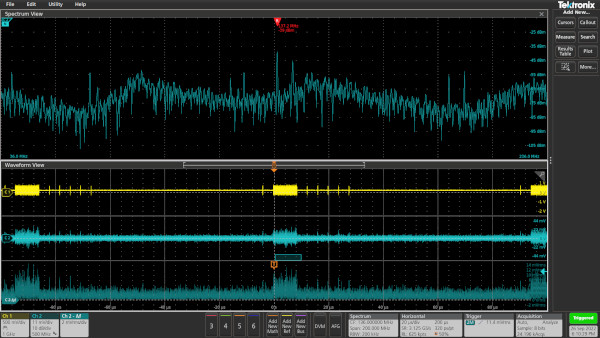
EMI 問題の原因となる放射エミッションの発生源を根絶するには、エミッションの構成を特定することが重要です。次に、エミッションの攻撃元と結合メカニズムを特定する必要があります。Spectrum View を備えた 4、5、または 6 シリーズ MSO などのミックスド ドメイン オシロスコープを使用すると、スペクトルと時間領域波形の同期ビューをキャプチャして、原因を迅速に特定できます。
- 任意のアナログ・チャンネルで波形、スペクトラム、またはその両方の表示が可能
- RF周波数または振幅の変化のプロットとトリガ
- スペクトルと時間領域波形が同期され、RFと時間領域イベントを相関させ、根本原因をより迅速に特定します。
- 中心周波数やRBWなどのスペクトル制御は時間領域制御から独立しており、スペクトルと波形の表示を最適化できます。
4、5、6 シリーズ MSO オシロスコープを使用した EMI トラブルシューティングの手順アプリケーション ノート
コンテンツ
新製品 - オールインワンのEMI/EMCプリコンプライアンス・ソフトウェア・ソリューションであるEMCVu
ビデオ
新製品の設計を認証ラボに提出する準備ができていることを判断するための、高速、簡単、正確、および購入しやすい方法を提供します。このビデオでは、ボタンによる複数の規格サポート、複数の測定/複数のフォーマットによる自動レポート作成、周囲雑音校正と比較、ピーク検波による高調波マーカと高速スキャン、およびQP検波と平均検波を使用した障害のスポット測定について説明します。
スペクトラム・アナライザを使用した低コストのEMIプリコンプライアンス・テスト
アプリケーション・ノート
このアプリケーション・ノートは、汎用スペクトラム・アナライザを使用して、コンプライアンス・ラボでの認証試験前に、放射および伝導エミッションのEMIプリコンプライアンス・チェックを実行する方法について説明しています。
完全なEMIコンプライアンス・チャンバとテクトロニクスのスペクトラム・アナライザ
ビデオ
このビデオでは、コンプライアンス・レシーバのセットアップを使用して得られたEMIコンプライアンスの結果と、テクトロニクスのRSAスペクトラム・アナライザを使用した低コストのアプローチを比較します。この結果から、EMIチャンバの内外における意図しない放射のエミッション・テストとCISPR 11 EMIの放射エミッション・テストがどのように相関しているかがわかります。 RSAスペクトラム・アナライザでプリコンプライアンス・テストを実施することにより、コンプライアンス・テストの前に対処できる問題を検出し、高価なコンプライアンス・テストに1度で合格して時間と費用を節約します。
Frequently Asked Questions (FAQ)
What is EMI?
Sometimes called radio frequency interference (RFI), electromagnetic interference (EMI) occurs when electromagnetic energy disrupts the operation of an electronic device. The source of EMI can be man-made, such as other electrical devices like switch-mode power supplies, personal computers, or naturally occurring, such as electrical storms, solar radiation, or even cosmic noises.

What is EMC?
Electromagnetic compatibility (EMC) is the ability of a device to operate as intended in an environment with other electrical devices or sources of EMI without affecting those other devices. A device is said to be EMC-compliant when it does not influence the electromagnetic environment to the extent that other devices and systems are negatively affected.
What is EMI and EMC testing?
To ensure compliance with EMI and EMC national and international regulations, many companies employ the services of a specialized testing facility. Since these tests are expensive—even if the product fails—several companies perform EMC pre-compliance testing in-house. If they have a sophisticated enough lab, companies may also perform EMC compliance testing in-house.
What is EMI pre-compliance testing?
What are the types of EMC tests?
When electronics are submitted to EMC testing labs, there are many types of EMC tests these labs run. Generally speaking, EMC testing is divided into two categories: immunity testing and emissions testing.
Immunity testing
Immunity testing is the process of transmitting RF energy onto a device under test (DUT) (also referred to as equipment under test or EUT) to determine if the DUT/EUT operates correctly when in such an environment.
Emissions testing
Emissions testing is the process of measuring the RF emissions – both radiated and conducted – of a DUT/EUT to determine if its emissions levels do not exceed the limits defined by the appropriate standard. Emissions testing includes both radiated and conducted emissions tests.
- Radiated emissions: Radiated emissions are the intentional and unintentional release of electromagnetic energy from an electronic device. A radiated test is performed to ensure emissions emanating from the DUT or EUT comply with the applicable limits.

-
Conducted emissions: Conducted emissions are the coupling of electromagnetic energy from a device to its power cord. Like radiated emissions, the allowable conducted emissions from electronic devices are controlled by different regulatory agencies and testing is performed to ensure emission levels are below the applicable limits.
-

What types of EMC testing labs are there?
EMC-compliance tests are commonly done off-site prior to the production of a device. Open-air test sites, or OATS, are the reference sites used for most standards. They are especially useful for emissions testing of large equipment systems. However, RF testing of a physical prototype is more often carried out indoors, in a specialized anechoic chamber. Types of chambers include anechoic, reverberation, and the gigahertz transverse electromagnetic cell (GTEM cell).
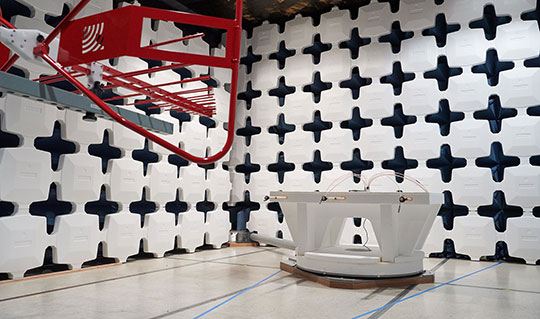
What is EMC testing procedure and average pass rate?
Roughly 50 percent of products pass their first EMC compliance test when pre-compliance isn’t considered, so it’s essential to understand the process and standards a device is tested to in order to increase your chances of success.
- Know your standards: There are a variety of EMC standards that specify test procedures and limits for radiated and conducted emissions. These vary by country and type of equipment under test. The first step in testing is determining which standards apply to your product, and researching the testing procedures and limits required for compliance.
- Conduct pre-compliance EMC testing: EMC compliance testing can take up to two weeks to complete—not including the time it takes to get your product into the test queue—and can cost up to $20,000 per submission. A failure in EMC compliance can result in expensive redesigns and product launch delays. And since nearly 50 percent of products fail their first EMC compliance test when pre-compliance isn’t considered, it’s likely that you’ll need to repeat your visit to the test house, multiplying costs over time.
- Find an EMC testing lab: Once a product has gone through pre-compliance testing and passed the test with a sufficient margin, it needs to be formally certified by an EMC testing lab. Accredited labs are the gold-standard for EMC testing and choosing an accredited lab is always recommended—though not necessary—to ensure your device is ready to go to market. There are, however, some instances that require certification from an FCC-accredited lab, including devices that fall under the 'certification' authorization procedures.
What products are needed for EMI and EMC testing?
The goal of EMC pre-compliance testing is to mimic the compliance test set up within an acceptable margin to uncover potential problems and reduce risk of failure prior to the expensive compliance test. EMC pre-compliance testing typically involves:
- Spectrum analyzer with quasi-peak detector
- Preamplifier (optional)
- Antenna with non-metallic stand for radiated emissions
- Line impedance stabilization network (LISN) for conducted test
- Power limiter for conducted test
- EMC near-field probes for diagnostics (optional)
- Oscilloscope with frequency and time correlation capabilities to assist in debugging (optional)
- EMC testing software
How to set up a pre-compliance EMC test lab?
When selecting a test site, rural areas, conference rooms, and basements are good options because they minimize external signals that might mask the DUT emission levels you are trying to measure. Other considerations for improving accuracy include having a good ground plane and reducing the number of reflective objects around the test area.
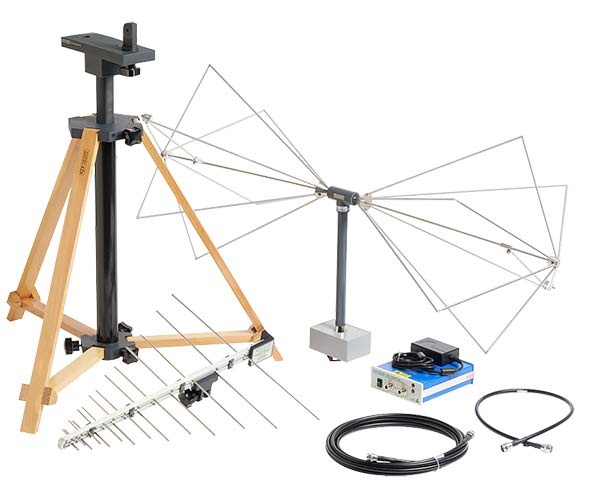
How to pass EMC compatibility testing?
EMC pre-compliance testing is a fast and affordable way to ensure products pass EMC tests the first time In the early development stages, design-for-EMC techniques are combined with diagnostics to build products with low susceptibility to both external and internal interference. Later in the development cycle, pre-compliance testing is used to catch compliance problems and improve the probability of a successful first pass of full EMC-compliance testing.
Additional benefits of pre-compliance EMC testing, include:
- Detects errors early, fixing potential issues
- Lowers testing and design costs
- Projects become more agile
- Lowers risk of failure and leads to assured compliance
- Addresses both over and under design and engineering
- Full EMI Compliance Chamber vs Tektronix Spectrum Analyzer




